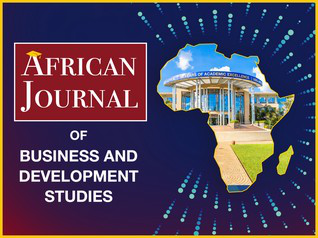Influence of Maasai Cultural Orientation on Entrepreneurial Tourism Activities in Kajiado County, Kenya
DOI:
https://doi.org/10.70641/ajbds.v2i1.168Keywords:
Tourism, Entrepreneurial, Cultural orientation, Sustainable Development, Cultural EnterprisesAbstract
Entrepreneurial tourism is an essential part of sustainable economic development. However, the specific contribution of cultural tourism to local economic empowerment remains underexplored. The study investigated the influence of Maasai cultural orientation on entrepreneurial tourism activities in Kajiado County, Kenya. The study adopted a cross-sectional survey design with a sample of 168 respondents. Both quantitative and qualitative primary data were collected through semi-structured questionnaires and key informant interviews. Data analysis involved descriptive statistics and linear regression for quantitative responses, and thematic analysis for qualitative responses. The study sample comprised 168 respondents, majority female (55%), predominantly aged 36-45 years (42%), with 73% having at least primary education and varied representation across community-based, private, NGO, and government sectors. Findings indicate that Maasai cultural orientation has a significant influence on the development of entrepreneurial tourism ventures in the region. Cultural assets such as traditional attire, beadwork, architectural styles, and music were utilized in cultural tourism, albeit to varying degrees. Products related to rites of passage and cuisine were moderately integrated, while others remained underexploited. Major barriers to effective community participation and community benefitting from cultural tourism were inherent cultural attitudes and practices, clanism, unfavourable local government policies, and lack of entrepreneurial skills and financial resources. Regression analysis revealed that forms of cultural tourism products (β = 0.212), Maasai cultural orientation (β = 0.197), investment factors (β = 2.109), and cultural challenges (β = 0.941) were all statistically significant predictors of entrepreneurial cultural tourism activities (p < 0.01), with the strongest influence observed for investment-related factors. The study concludes that there is a significant relationship between Maasai cultural orientation, cultural challenges, and tourism products in Kenya. The study recommends community sensitization, the creation of a harmonized system of 'organized culture', ownership of cultural tourism enterprises by the local community, protection from mass tourists, and initiation of tourism economic activities through strategic investments.
References
Bourdieu, P. (1986). The forms of capital. In J. Richardson (Ed.), Handbook of theory and research for the sociology of education (pp. 241–258). Greenwood.
Community-Based Tourism Study. (2025). Community-based tourism as a catalyst for achieving the United Nations Sustainable Development Goals: One and eight. Global CBT Research. https://www.researchgate.net/publication/389020251
Condé Nast Traveler. (2024, December 25). In Kenya, community-based initiatives are redefining the conservation model. Condé Nast Traveler. https://www.cntraveler.com/story/in-kenya-community-initiatives-are-redefining- conservation
Cooper, C., Fletcher, J., Gilbert, D., & Wanhill, S. (1998). Tourism: Principles and practice (2nd ed.). Longman.
Gerard, B., & Shaker, A. (2002). Culture and entrepreneurship: A cross-regional analysis. Journal of Developmental Entrepreneurship, 7(3), 219–241.
Hegarty, C., & Przezborska, L. (2005). Rural and agri-tourism as a tool for reorganizing rural areas in old and new member states: A comparison study of Ireland and Poland. International Journal of Tourism Research, 7(2), 63–77. https://doi.org/10.1002/jtr.513 DOI: https://doi.org/10.1002/jtr.513
Hsieh, H.-F., & Shannon, S. E. (2005). Three approaches to qualitative content analysis. Qualitative Health Research, 15(9), 1277–1288. https://doi.org/10.1177/1049732305276687 DOI: https://doi.org/10.1177/1049732305276687
Jenkins, C. L., & Henry, B. M. (2001). Government involvement in tourism in developing countries. Annals of Tourism Research, 28(3), 678–691. https://doi.org/10.1016/S0160-7383(00)00078-6
Kalisch, A. (2001). Tourism as fair trade: NGO perspectives. Tourism Concern.
Manyara, G., & Jones, E. (2005). Community-based tourism enterprises development in Kenya: An exploration of their potential as avenues of poverty reduction. Journal of Sustainable Tourism, 13(6), 628–644. https://doi.org/10.1080/09669580508668568 DOI: https://doi.org/10.2167/jost723.0
Morong’, D. R. (2025). Economic resilience strategies and tourism sustainability post COVID-19 recovery period in Kenya. Journal of Business Management and Innovation, 3(1), 44–61. https://jbmij.org/system/index.php/home/article/view/46
Mueller, S. L., & Thomas, A. S. (2000). Culture and entrepreneurial potential: A nine- country study of locus of control and innovativeness. Journal of Business Venturing, 16(1), 51–75. https://doi.org/10.1016/S0883-9026(99)00039-7 DOI: https://doi.org/10.1016/S0883-9026(99)00039-7
North, D. C. (1990). Institutions, institutional change and economic performance. Cambridge University Press. DOI: https://doi.org/10.1017/CBO9780511808678
Odunga, S. (2024). Community support and socioeconomic impacts of cultural tourism in rural Kenya. Tourism and Hospitality, 5(4), 84. https://doi.org/10.3390/tourhosp5040084 DOI: https://doi.org/10.3390/tourhosp5040084
Ondicho, T. G. (2010). Tourism, development and poverty reduction: A case study of Maasai tourism in Kenya. Journal of Sustainable Tourism, 18(6), 773–790. https://doi.org/10.1080/09669581003653501
Rajwais, J. B., Rotich, L. K., & Mapelu, I. C. (2025). Cultural tourism in Kenya: A systematic review of opportunities, challenges, and sustainable development pathways. African Journal of Tourism and Hospitality Management, 4(1), 260–267. https://doi.org/10.37284/ajthm.4.1.3245 DOI: https://doi.org/10.37284/ajthm.4.1.3245
Republic of Kenya. (1994). Sessional Paper No. 2 on Small Enterprises and Jua Kali Development in Kenya. Government Printer.
Republic of Kenya. (2006). Economic survey. Kenya National Bureau of Statistics.
Saleemi, N. A. (2009). Entrepreneurship simplified. Saleemi Publications.
Song, D. (2016). Countermeasure study on sustainable utilization of tourism resources and tourism environmental pollution in coastal areas of the Pearl River Delta, China. Nature Environment and Pollution Technology, 15(3), 873–878.
Swanson, K. K., & DeVereaux, C. (2017). A theoretical framework for sustaining culture: Culturally sustainable entrepreneurship. Annals of Tourism Research, 62, 78–88. https://doi.org/10.1016/j.annals.2016.12.003 DOI: https://doi.org/10.1016/j.annals.2016.12.003
Tosun, C. (2000). Limits to community participation in the tourism development process in developing countries. Tourism Management, 21(6), 613–633. https://doi.org/10.1016/S0261-5177(00)00009-1 DOI: https://doi.org/10.1016/S0261-5177(00)00009-1
Tosun, C., Timothy, D. J., & Timur, S. (1998). Tourism and community development. Annals of Tourism Research, 25(4), 902–905. https://doi.org/10.1016/S0160-7383(98)00045- 6
Tshikuku, K. (2001). Culture, entrepreneurship and development in Africa. Paper presented at the International Conference on the Cultural Approach to Development in Africa, Dakar, Senegal. UNESCO.
World Tourism Organization. (2002). Tourism and poverty alleviation. WTO Publications.
World Travel & Tourism Council. (2008). Kenya travel & tourism: Economic impact. WTTC.
World Travel & Tourism Council. (2024). Travel & tourism economic impact research: Kenya. WTTC.
Downloads
Published
How to Cite
Issue
Section
License
Copyright (c) 2025 Sylvia Nyambura Mureu, Bernard K. Nassiuma, & Stephen Irura Ng’ang’a

This work is licensed under a Creative Commons Attribution-NonCommercial-ShareAlike 4.0 International License.





 This work is licensed under a
This work is licensed under a 